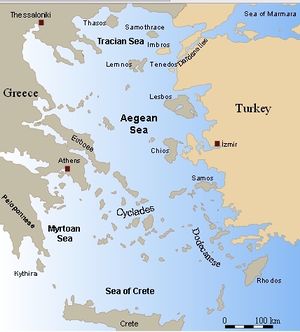Myrtoan Sea
Seas of the World  The Myrtoan Sea (also Mirtoan Sea) is part of the Aegean Sea and the largerMediterranean Sea.
The Myrtoan Sea (also Mirtoan Sea) is part of the Aegean Sea and the largerMediterranean Sea.
The Myrtoan Sea is bounded by the Cyclades islands to the east and by the Peloponesse Peninsula to the west and by the Sea of Crete to the south.
Antiquity
The Myrtoan Sea was one of the first seas of the world to appear in recorded history. Strabo l insights as to the dimensions, limits and specifc islands within the Myrtoan. In antiquity the northern, western and eastern limits are in accord with modern designations, although the southern limits extended clearly to the island of Crete itself; this southern limit would have included the ancient port of Kydonia on the Gulf of Chania, a Minoan stronghold and ancient trading center well known to the mainland Greeks. In fact Kydonia, at the southern limit of the Myrtoan Sea, was an important staging area for Greek ships continuing further into the distant Mediterranean ports visited by the ancient Greek mariners.
The name of the sea is traditionally derived from Myrtilus, charioteer to Oenomaus in Greek mythology. According to myth, Myrtilus was thrown into the sea by Pelops king of Pisa in the Peloponnesus.
References
- Roberto Danovaro et al. 2010. Deep-Sea Biodiversity in the Mediterranean Sea: The Known, the Unknown, and the Unknowable. PLoS ONE 5(8)
- C. Michael Hogan. 2008. Cydonia, The Modern Antiquarian
- Horace Leonard Jones and John Robert Sitlington Sterrett. 1917 The geography of Strabo: Volume 1 - Page 477 books.google.comStrabo,
- T. Taymaz, Y. Yilmaz and Y. Dilek. 2008. The Geodynamics of the Aegean and Anatolia, Geological Society of London. ISBN: 1862392390
- POEM Group. General circulation of the Eastern Mediterranean. Earth-Science Reviews, 32: 309, 1992.
- K. I. Stergiou, E. D. Christou, D. Georgopoulos, A. Zenetos, and C. Souvermezoglou. 1997. The Hellenic Seas: Physics, chemistry, biology and fisheries. Oceanog. Marine Biol. Ann. Rev., 35: 538
